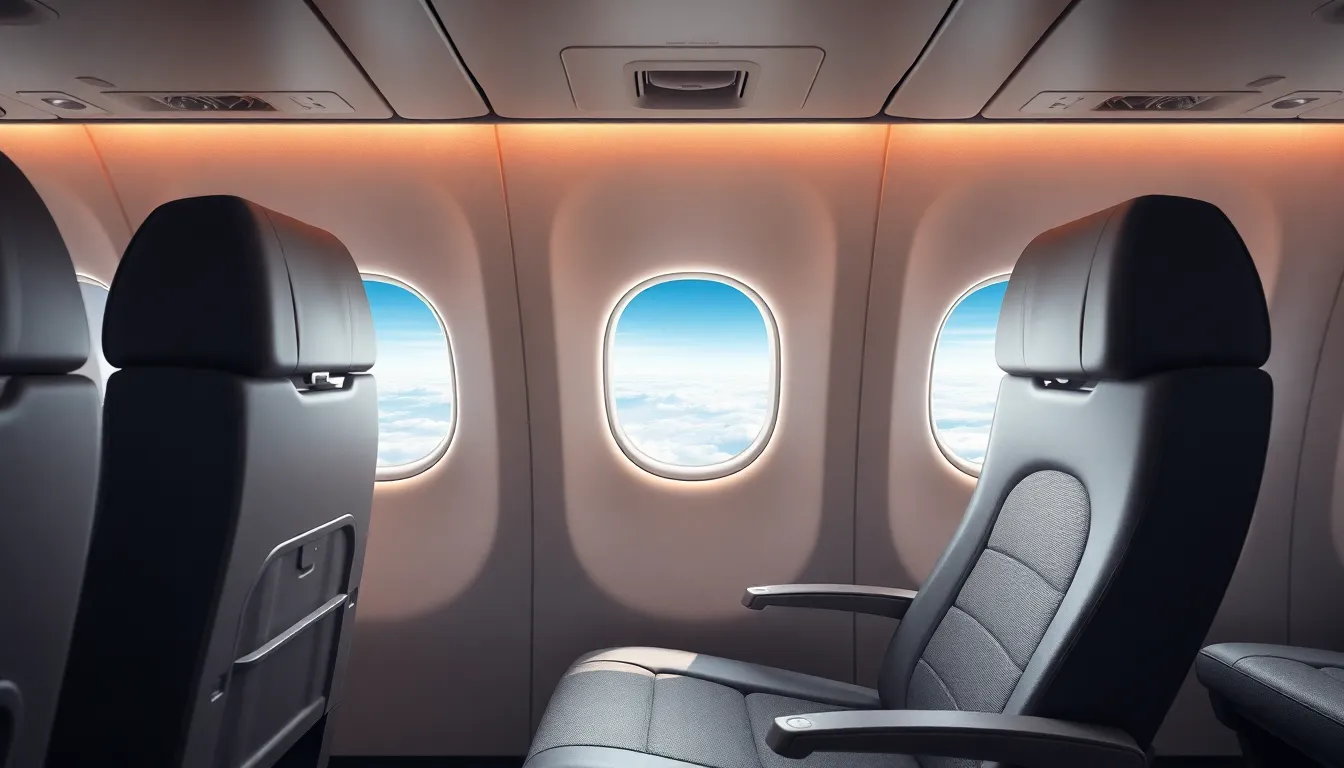When booking a flight, seat selection can make all the difference in the travel experience. Passengers often find themselves debating the merits of window seats versus aisle seats. Among the various seat options, one question frequently arises: is seat F a window seat? Understanding the seating arrangement can help travelers maximize their comfort and enjoyment during the journey.
Window seats offer breathtaking views and a cozy spot to lean against, making them a popular choice for many. However, the layout of an aircraft can vary significantly between airlines and aircraft models. This article will delve into the specifics of seat F and clarify whether it truly provides that coveted window view, ensuring travelers make informed decisions for their next adventure.
Table of Contents
ToggleOverview of Window Seating
Window seats offer unique advantages for air travel, enhancing the overall experience for passengers. Passengers can enjoy breathtaking views and natural light, making long flights more enjoyable. Window seating also provides a sense of privacy, as passengers are less likely to be disturbed by fellow travelers.
Seat F, in most aircraft configurations, is often positioned near the wing or in the rear section. Understanding the specific layout of the aircraft becomes essential to determine whether seat F is indeed a window seat. Typical arrangements show that seat F on many airline models often occupies a window location, providing passengers with direct access to the view outside.
Benefits of window seating include:
- Scenic views: Passengers can gaze at landscapes, clouds, and sunsets.
- Less disturbance: Window seat passengers experience fewer interruptions compared to those in aisle seats.
- Ideal for photography: Travelers in window seats can capture memorable moments during flights.
While preferences for seating may vary, the appeal of window seats remains strong among many travelers. Ensuring correct seat selection maximizes comfort and fulfillment during the journey.
Understanding Airline Seat Configurations

Airline seat configurations vary significantly across different aircraft, affecting passenger comfort and overall experience. Familiarity with common seating terms and the importance of seat selection empowers travelers to make informed choices.
Common Terms and Definitions
- Window Seat: A seat located next to the window, providing views of the outside.
- Aisle Seat: A seat adjacent to the aisle, allowing easier access to restrooms and movement within the cabin.
- Middle Seat: A seat positioned between two other seats, offering less personal space.
- Exit Row: A row of seats near emergency exits, often providing extra legroom.
- Bulkhead Seat: A seat located at the front of a section, typically with more legroom but lacking under-seat storage.
- Configuration: The arrangement of seats in an aircraft, including the number of seats per row and their layout.
- Pitch: The distance between a point on one seat and the same point on the seat in front or behind, usually measured in inches.
- Width: The measurement of a seat from armrest to armrest, affecting overall comfort.
Importance of Seat Selection
Seat selection plays a crucial role in the overall flight experience. Choosing the right seat can lead to increased comfort and satisfaction during travel. Window seats, like seat F in many aircraft configurations, offer scenic views and enhanced privacy. Aisle seats provide ease of access and flexibility for movement, which can benefit travelers on long flights.
Understanding the specific layout of an aircraft’s seating can clarify options available for selection. Factors such as personal preference for legroom, proximity to restrooms, or desire for a quiet environment should guide choices. Incorporating these considerations leads to a more enjoyable journey, maximizing comfort and fulfillment on flights.
Analyzing the “F” Seat
Understanding the specifics of seat F is essential for travelers aiming for an optimal flying experience. This section explores its positioning and benefits.
Positioning in Different Aircraft
Seat F is commonly found in various aircraft models, usually identified as a window seat. In narrow-body jets, such as the Boeing 737 and Airbus A320, it’s positioned on the left side of the aircraft. In wide-body aircraft like the Boeing 777 and Airbus A350, seat F often remains a window seat, although its location may change based on the airline’s seating configuration. It often appears in rows 1 to 10, particularly in the economy class section.
Table 1 below summarizes common configurations for seat F across major aircraft:
| Aircraft Model | Seat Configuration | F Seat Position |
|---|---|---|
| Boeing 737 | 3-3 | Aisle or Window |
| Airbus A320 | 3-3 | Window |
| Boeing 777 | 3-4-3 | Window |
| Airbus A350 | 3-3-3 | Window |
Benefits of the “F” Window Seat
Choosing seat F offers numerous advantages. It provides stunning aerial views, ideal for sightseeing during flights. Natural light entering through the window enhances the in-flight experience. Travelers seated in F often enjoy reduced disturbances from other passengers, particularly during boarding and meal services.
Moreover, seat F provides a sense of privacy, enabling personal space to relax or work. Its proximity to the window allows for ideal photo opportunities, which is a significant advantage for photography enthusiasts. Overall, selecting seat F makes the journey more enjoyable and fulfilling for passengers.
Comparing “F” with Other Window Seats
Understanding how seat F compares with other window seats enhances the decision-making process for travelers. Seat configurations differ by airline and aircraft model, affecting passenger comfort and experience.
Pros and Cons
Pros of Seat F:
- Scenic views: Seat F usually provides unobstructed views of the landscape during flight.
- Natural light: It allows ample daylight, creating a pleasant atmosphere.
- Reduced disturbances: Sitting by the window often means fewer interruptions from fellow passengers.
- Ideal for photography: Window seats like F offer prime opportunities to capture aerial shots.
Cons of Seat F:
- Limited accessibility: Passengers seated in F may face challenges getting up, especially during meal service or turbulence.
- Proximity to wing: In many configurations, seat F is near the wing, which can obstruct views during takeoff and landing.
- Noise exposure: Aircraft engines often produce noise from the wing area, potentially impacting comfort.
- Less legroom: Some seating arrangements place seat F closer to the bulkhead or wall, limiting legroom compared to other window seats.
Passenger Preferences
Passenger preferences vary widely when selecting seats. Many travelers favor window seats for the views and personal space, while others opt for aisle seats for easier access to the aisle. Specific statistics show that approximately 40% of travelers prioritize window seating for leisure trips, highlighting a desire for scenic experiences.
Within the context of seat F, preferences often hinge on flight duration, travel purpose, and individual comfort needs. Short-haul flights may see less emphasis on window seating, while long-haul journeys increase the allure of seat F. Research indicates that window seat passengers typically experience greater satisfaction during flights, reinforcing the appeal of seat F among discerning travelers.
Choosing the right seat can greatly enhance the flying experience. Seat F often stands out as a popular choice for those seeking a window seat. With its prime location on many aircraft it offers stunning views and a sense of privacy that many travelers appreciate.
While it provides several advantages such as natural light and fewer disturbances it’s essential for passengers to weigh their personal preferences against potential downsides like limited accessibility. Ultimately understanding seat configurations and the specifics of seat F empowers travelers to make informed decisions that can lead to a more enjoyable journey.



